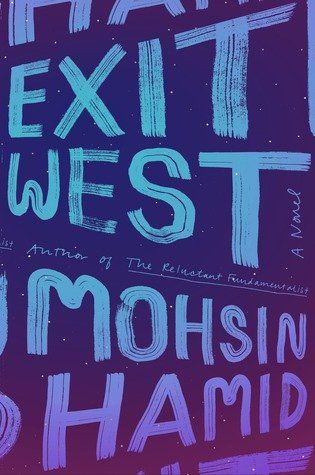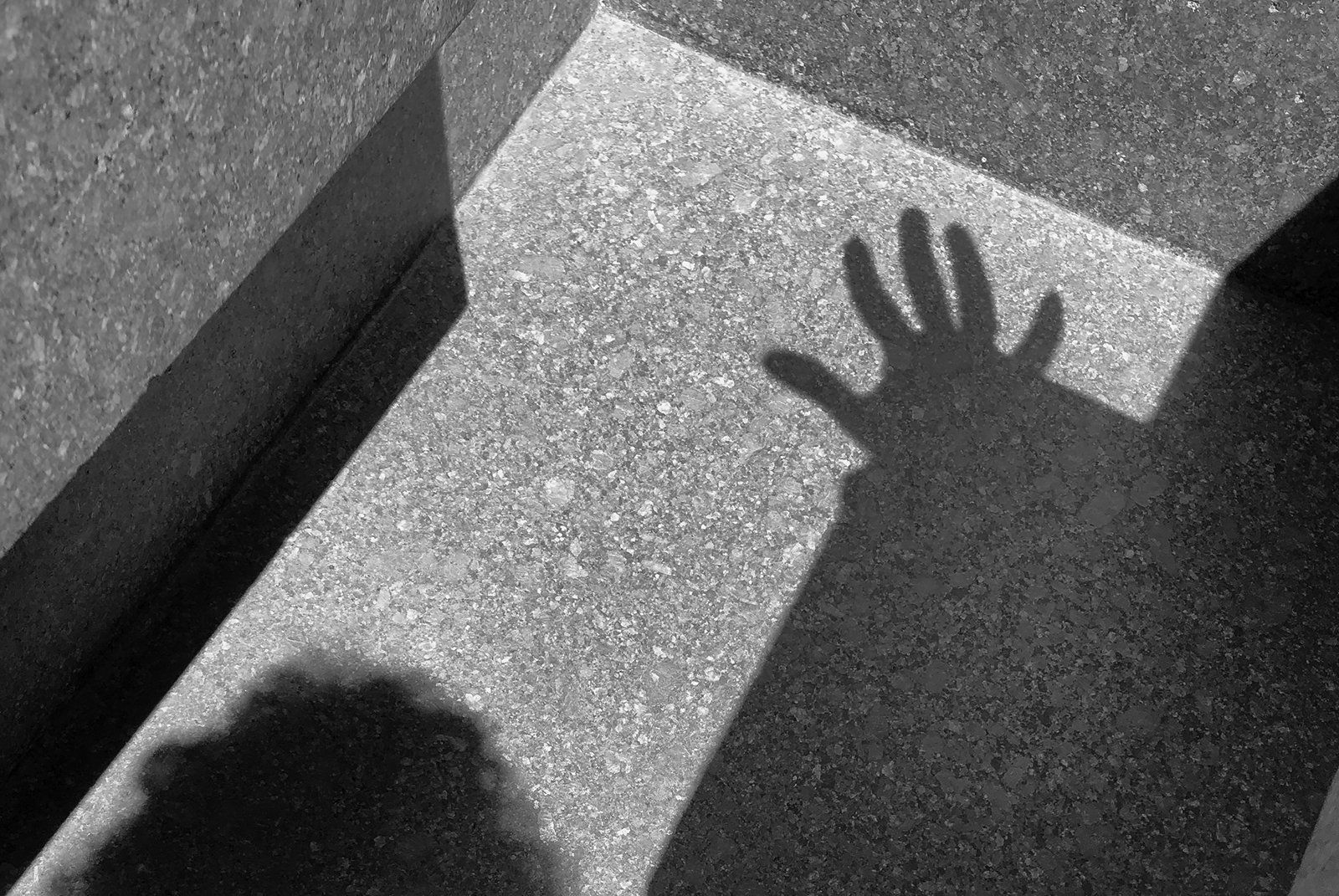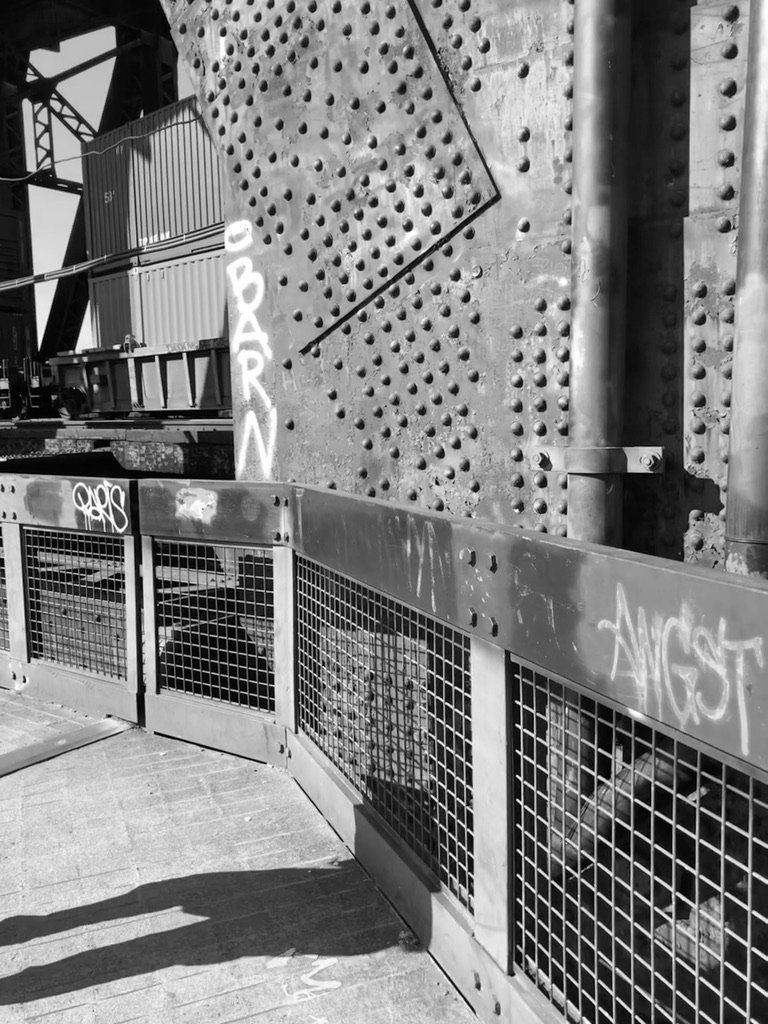
Please scroll down for English.
La oscuridad de las puertas
porque cuando migramos, asesinamos de nuestras vidas a aquellos a quienes abandonamos.
—Mohsin Hamid
“En una ciudad rebosante de refugiados, pero todavía mayoritariamente en paz, o por lo menos aún sin haberse declarado en guerra abierta, un chico conoció a una joven en un salón de clase y no le habló.[1]” Estas palabras con las que inicia la novela Exit West de Mohsin Hamid funcionan como una manera de advertencia de lo que le espera al lector. El tono remite en parte a una trivial novela romántica —el anuncio de un Romeo y una Julieta de nuestra época—, pero también nos advierte sobre la tragedia inminente de la guerra que, si no ha estallado, sus primeras explosiones ya se escuchan a poca distancia. El final de esta primera oración nos anuncia un posible desconsuelo, algo urgente, la necesidad de acelerar el acontecer de la existencia antes de que lo inevitable tome las riendas del devenir individual. La ciudad, rebosante de refugiados y cuyo nombre nunca se nos revela, está por lo pronto mayoritariamente en paz o, por lo menos, aún sin que la guerra irrumpa de lleno en sus calles. Aunque parezca extraño, sus residentes llevan a cabo rutinas como en cualquier otro sitio, como si hubiera un futuro. La voz que narra y que todo conoce nos lo muestra con claridad conforme volteamos a la segunda página:
Podría parecer extraño que en ciudades al borde del abismo los jóvenes sigan yendo a clase […] pero así son las cosas, en las ciudades como en la vida, porque en un momento estamos distraídos con los quehaceres cotidianos y al siguiente estamos muriendo, y lo inminente de nuestro final eterno no pone un alto a nuestros fugaces principios e intermedios hasta el instante en que los para de golpe.
En cierta medida la tragedia está contada. Hay una sensación de adversidad irrevocable en esa comparación entre lo cotidiano y la muerte, igual que una futilidad en el ímpetu ininterrumpido de lo efímero. Sin embargo, hay mucho más qué decir. En el recuento de esas individualidades y sus particulares recorridos de vida es donde aparece el sentido de lo humano en su conjunto y es por ello que se hace indispensable acelerar el acontecer.
En esta novela acompañamos a un personaje dual. Saeed y Nadia no son dos protagonistas, sino dos partes de un lazo protagónico, reforzado por un complejo sentimiento mutuo que trasciende al amor común. El héroe de esta novela no es una ni otro, sino la solidaridad entre ambos. Nadia y Saeed se adaptan a sus circunstancias de maneras distintas o hasta opuestas —las sutiles diferencias del principio de su relación se agudizan con el tiempo—, pero su unión es la columna que les permite sobrellevar los acontecimientos, incluyendo el de padecerse uno a otra y viceversa mientras se ven obligados a navegar juntos las adversidades que se suceden en cascada.
Exit West es una historia realista y cruda en su mayoría, sin ser en absoluto sanguinaria; es un relato devastador en el que la esperanza nos guía de un lado a otro, de oriente a occidente, a través de puertas oscuras que emergen entre lo cotidiano; puertas metafóricas que nada tienen que ver con el acontecer del día a día; puertas que son “tanto un principio como un final”. En este sentido, la traducción del título al español publicado por Reservoir Books, Bienvenidos a Occidente, me parece que no representa el juego de palabras que encontramos en el título original, y por ello decidí dejarlo aquí en inglés. Quizás un título más afortunado en la versión castellana sería Salida a Occidente, ya que, si bien no expresa la ambigüedad de Exit como imperativo o sustantivo, sí retrata uno de los elementos esenciales de la acción contada. La novela se sitúa justo en este umbral entre realidad y magia: las puertas que se abren hacia una oscuridad total son como túneles hacia posibilidades de escape para salir de lo adverso, son la vía hacia la tácita esperanza de Occidente.
Hamid hace uso de este elemento casi fantástico y le ahorra así al lector el sufrimiento implícito en el hecho mismo de las migraciones que, si bien no son necesariamente forzadas, para muchos representan la única alternativa de transición hacia la libertad. En la novela no vemos nada de lo que las noticias de nuestra realidad nos entregan en los diarios constantemente: no hay descripciones de naufragios, cuerpos arrastrados por la corriente, muros fronterizos ni muertes en el desierto. Lo que observamos son personajes que cruzan ese umbral negro y reaparecen, no sabemos cuánto tiempo después, en otra ciudad y país. Al ver emerger a los personajes del otro lado, podríamos argumentar que estas puertas son conductos mágicos. Pero lo que acontece en el pasaje se nos oculta y no necesariamente significa que no estuvo lleno de penurias y sufrimiento. Por lo contrario, vemos a Saeed y Nadia salir extenuados, aunque no se nos muestre lo que ocurrió en el transcurso ni conozcamos su duración. En su lugar, la voz que narra de inmediato vuelca nuestra mirada de lectores sobre la interacción de estos personajes con las sociedades que los reciben, de manera que el asunto para nosotros, desde los márgenes de la novela, se vuelve mucho más íntimo y también incómodo: quedamos confrontados con nuestra capacidad de empatía y con nuestra actitud personal ante el papel que nos toca como anfitriones involuntarios de estas personas que se instalan a nuestro alrededor.
Al avanzar en la novela nos vamos adentrando íntimamente en la relación entre Nadia y Saeed. Así, el apego que ya sentimos hacia ellos crece al encontrar tantas similitudes entre nosotros, los residentes lectores, y la pareja de inmigrantes. Más allá de su circunstancia, se nos parecen demasiado; podrían ser nuestros primos o amigos. Y este asunto es lo que distingue a este libro de otros recuentos sobre migrantes literarios. Hamid no se interesa en la transición y el abuso ni en el sufrimiento físico, sino en la adaptación o falta de ésta de los autoexiliados dentro de sociedades establecidas, mientras al mismo tiempo elaboran el duelo por los seres queridos que abandonaron. El narrador retrata la manera en que estas comunidades, a su pesar o no, quedarán profundamente transformadas también. Salida a Occidente es un relato sobre esta reorganización de la sociedad global y sus repercusiones, es la historia de una revolución sin caudillo que ocurre como un ímpetu que se alimenta a sí mismo y que, una vez que comienza, no tiene vuelta atrás. Con su movimiento los migrantes crean conexiones como surcos invisibles, como lechos de ríos que con el transportar de las aguas se ahondan cada vez más. Así, en cada uno de los capítulos, salvo en el último que es más bien un epílogo, hay un pasaje en que la historia se detiene para dar lugar a la irrupción de personajes volátiles que, al cambiar de página, habrán desaparecido sin dejar rastro y sin volver a ser mencionados. Sin embargo, cada uno de éstos podría ser el apunte preliminar de otra novela. Leemos sobre una mujer de piel pálida que duerme en Sydney, mientras que de la oscuridad de su closet surge un hombre Negro que se desliza hacia el exterior por su ventana sin que ella se entere; o sobre el contador londinense al borde del suicidio que cruza el umbral hacia Namibia; o sobre la familia tamil que emerge de un portón oscuro en un centro comercial en Dubái mientras las cámaras de vigilancia registran cada uno de sus pasos.
Conforme el relato de Nadia y Saeed sigue su curso, las puertas que estos otros personajes etéreos cruzan se tornan más flexibles, más abiertas, más transitables. Se pueden atravesar de ida y vuelta, convirtiéndose así en un elemento más de la cotidianidad de quien esté dispuesto a aceptarlas.
Para navegar todos estos sucesos paralelos, Hamid echa mano de un lenguaje fluido casi en exceso. Eventos, sentimientos e ideas se suceden unas tras otros, entrelazando lo práctico y sus obstáculos con monólogos internos que revelan el alma de los personajes. A pesar de la crudeza de lo que esta novela nos presenta, Salida a Occidente es tan esperanzadora como determinista; posee una dualidad que no difiere de la que Nadia percibe en su interior:
[U]na vez que Nadia estaba sentada en los escalones a la entrada de un edificio frente a un destacamento de tropas y un tanque para leer las noticias en su teléfono le pareció ver en línea una fotografía de sí misma sentada en los escalones de un edificio leyendo las noticias en su teléfono frente a un destacamento de tropas y un tanque, y se asustó, y se preguntó cómo era posible, cómo podía leer esta noticia y ser la noticia, y cómo podría el periódico haber publicado instantáneamente esta imagen de ella, y se fijó para ver si había algún fotógrafo cerca, y tuvo la extraña sensación de que el tiempo se torcía en su derredor, como si ella viniera del pasado y leyera sobre el futuro, o del futuro y leyera sobre el pasado, y casi sintió que si se levantaba en este momento para irse a casa habría dos Nadias, que se partiría en dos Nadias, y una se quedaría leyendo en los escalones y la otra se iría caminando a casa, y dos vidas diferentes se desdoblarían para estos dos diferentes yoes, y pensó que estaba perdiendo el equilibrio, o probablemente la cabeza, y entonces agrandó la imagen y vio que la mujer vestida con la toga negra que leía las noticias en su teléfono de hecho no era ella en absoluto.
Por un lado, somos testigos de esta sensación de desdoblamiento y, por otro, percibimos la lealtad que une a Nadia y Saeed, un compromiso que se fortalece con la vivencia común. En este tiempo crucial nuestros protagonistas comparten experiencias determinantes, formativas del ser, y a la vez mantienen la esperanza mediante el vínculo que los une más allá de las formas tradicionales de relacionarse.
Conforme el relato nos lleva desde una ciudad sin nombre en el Medio Oriente primero hacia Mikonos, luego a Londres y, finalmente, al área de la Bahía de San Francisco, la idea de lo nativista queda expuesta en paralelo: un establishment que trata de aplicar una política de dudosa protección a favor de los residentes originarios contra los supuestos peligros que los inmigrantes les pueden significar. La línea entre nativismo y xenofobia se borra gradualmente, casi al punto de desaparecer, y las acciones tomadas en favor de esta política se vuelven cada vez más cuestionables, se tornan en un asunto relativo y fútil que se desmorona ante los hechos.
Y en cuanto a Nadia y Saeed, al final del día, la dualidad de presencia y ausencia que viven permanece y sirve para navegar la nostalgia por los que se acompañan en su travesía y por aquellos a quienes abandonaron.
Portland, Oregon. Abril, 2021.
1] Esta traducción del original en inglés al español es mía, al igual que todas las subsecuentes.
The Darkness of Doors
for when we migrate, we murder from our lives those we leave behind.
—Mohsin Hamid
“In a city swollen by refugees but still mostly at peace, or at least not yet openly at war, a young man met a young woman in a classroom and did not speak to her.” These opening words of Mohsin Hamid’s Exit West act as a warning for what awaits the reader. The tone refers partly to a trivial romance—the foretelling of a Romeo and a Juliet of our times—but it also warns us about the imminent tragedy of war, a conflict that might not have burst out yet, but whose first explosions are already heard from a short distance. The end of this first sentence announces the possibility of despair, an urgency, the need to accelerate the occurrences of life before the inevitable takes charge of the individual fates. The city, swollen by refugees, and whose name is never revealed to us, is mostly at peace, or at least the war has not erupted fully in its streets. Though it might feel strange, its residents go about their routines like in any other place, as if there were a future. The omniscient narrating voice shows this clearly, as we turn to the next page:
It might seem odd that in cities teetering at the edge of the abyss young people still go to class […] but that is the way of things, with cities as with life, for one moment we are pottering about our errands as usual and the next we are dying, and our eternally impending ending does not put a stop to our transient beginnings and middles until the instant when it does.
To some degree, the tragedy is foretold. There’s a feeling of irrevocable adversity in that comparison between the trivial and death, and also a futility for the uninterrupted momentum of the ephemeral. However, there is much more to be said. In recounting these individualities and their particular life journeys is where the sense of the human as a whole appears, and that is what makes it essential to accelerate the events.
In this novel we walk side by side with a dual character. Saeed and Nadia are not two protagonists, but the two parts of a protagonist bond, reinforced by a complex mutual feeling that transcends common love. The hero of this novel is not one or the other, but the solidarity between the two. Nadia and Saeed adapt to their circumstances in different or even opposite ways—the subtle differences at the beginning of their relationship intensify over time—but their tie is a pillar that allows them to endure the events, including having to suffer one another while they are forced to navigate together the adversities that cascade on their path.
Exit West is primarily a realistic and harsh story, without being gore; it is a devastating account in which we are led by hope, from east to west, through dark doors that emerge in the middle of the daily routine; metaphoric doors that have nothing to do with the everyday life; doors that are “equally like a beginning and an end”. The novel is placed in the precise threshold between reality and magic: the doors that open to total darkness are like tunnels that lead to possibilities of an escape from the adverse, they are the path toward the tacit hope of the West.
Hamid uses this almost fantastic element, and thus saves the reader from going through the implicit suffering that immigrations pose, migrations that, even when they are not forced, are for many the only alternative of transitioning to freedom. In the novel we do not see any of the news we get in real life newspapers: there are no descriptions of shipwrecks, corpses washed up onshore, border walls, or deaths in the desert. What we observe are characters crossing the black threshold and reappearing, some unknown time later, in another city and country. We could argue, as we see the characters emerge on the other side, that these doors are magic conduits. But we are not told what occurs in the passage, and that does not mean it was not necessarily filled with pain and suffering. On the contrary, even when we are not shown what happened during the journey or how long it lasted, we see Saeed and Nadia come out exhausted. In turn, the narrator’s voice gives us a glance of the interaction these characters have with the societies that receive them. The reader’s view from the novel’s margins becomes much more intimate and also disconcerting: we are confronted with our ability for compassion and our personal attitude toward the role we get to play as involuntary hosts of these people who settle around us.
As the novel moves forward we become more intimate with Nadia and Saeed’s relationship. The attachment we already feel for them grows as we find so many similarities between us, the readers-residents, and the immigrant couple. Beyond their circumstance, they resemble us too much—they could easily be our friends or our cousins. And this is what makes this book distinct from other accounts of literary migrants. Hamid is not interested in the transition and the abuse or in the physical pain—he wants to show us the process of adaptation, or lack thereof, that the self-exiled have to go through within the established societies, while at the same time they mourn the loss of the loved ones they left behind. The narrator portrays the way these communities, like it or not, will be deeply transformed as well. Exit West is an account about the reorganization of the global society and its repercussions, it is the story of a revolution without a leader that occurs as a momentum that feeds itself, and once it begins, there is no turning back. As they move, the migrants build connections like invisible ruts, like riverbeds transporting the waters that will carve them ever deeper. In each one of the chapters, except the last that is more of an epilogue, there is a passage in which the story stops to give way to some volatile characters that will disappear on the next page without a trace and without ever being mentioned again. However, each could be the preliminary note for another novel. We read about a pale skin woman sleeping in her Sydney apartment, while a Black man emerges from the darkness of her closet and slips to the street through the open window without her ever knowing; or about the London accountant on the verge of suicide who crosses the door into Namibia; or about the Tamil-speaking family that emerges from a dark door in a Dubai shopping mall, while the surveillance cameras keep track of every one of their steps.
As the narration about Nadia and Saeed keeps going, the doors these ethereal characters walk through become ever more flexible, more open, more transitable. They can be traveled forth and back, becoming just another part of the everyday for those willing to accept them.
In order to navigate all these parallel events, Hamid uses an almost excessively fluid language. Events, feelings, and ideas come one after the other in a succession, interlacing the practical and its hurdles with internal monologues that reveal the characters’ soul. Despite the severity of what this novel shows, Exit West is both hopeful and deterministic; it has a duality no different than the way Nadia perceives herself:
[O]nce as Nadia sat on the steps of a building reading the news on her phone across the street from a detachment of troops and a tank she thought she saw online a photograph of herself sitting on the steps of a building reading the news on her phone across the street from a detachment of troops and a tank, and she was startled, and wondered how this could be, how she could both read this news and be this news, and how the newspaper could have published this image of herself instantaneously, and she looked about for a photographer, and she had the bizarre feeling of time bending all around her, as though she was from the past reading about the future, or from the future reading about the past, and she almost felt that if she got up and walked home at this moment there would be two Nadias, that she would split into two Nadias, and one would stay on the steps reading and one would walk home, and two different lives would unfold for these two different selves, and she thought she was losing her balance, or possibly her mind, and then she zoomed in on the image and saw that the woman in the black robe reading the news on her phone was actually not her at all.
On the one hand, we witness this splitting unfold; on the other, we perceive the loyalty that binds Nadia and Saeed, a commitment that strengthens with the common experience. In this crucial time, our protagonists share events that are determining, self-shaping, and at the same time they keep the hope alive thanks to the bond between them—a bond that ties them beyond the traditional ways of relating.
As the story takes us from a nameless city in the Middle East, first to Mikonos, then to London and, finally, to the San Francisco Bay area, the idea of nativism is exposed in parallel: an establishment trying to enforce a policy of dubious protection of the original residents against the supposed danger immigrants may pose. The line between nativism and xenophobia is gradually erased almost to the point of disappearing, and the actions taken toward this policy become ever more questionable, a relative and futile matter that crumbles amidst the events.
As for Nadia and Saeed, at the end of the day, the duality of presence and absence they live through lingers and serves to navigate the nostalgia for the ones who stay together in their journey and for those they left behind.
Portland, Oregon. April, 2021.







